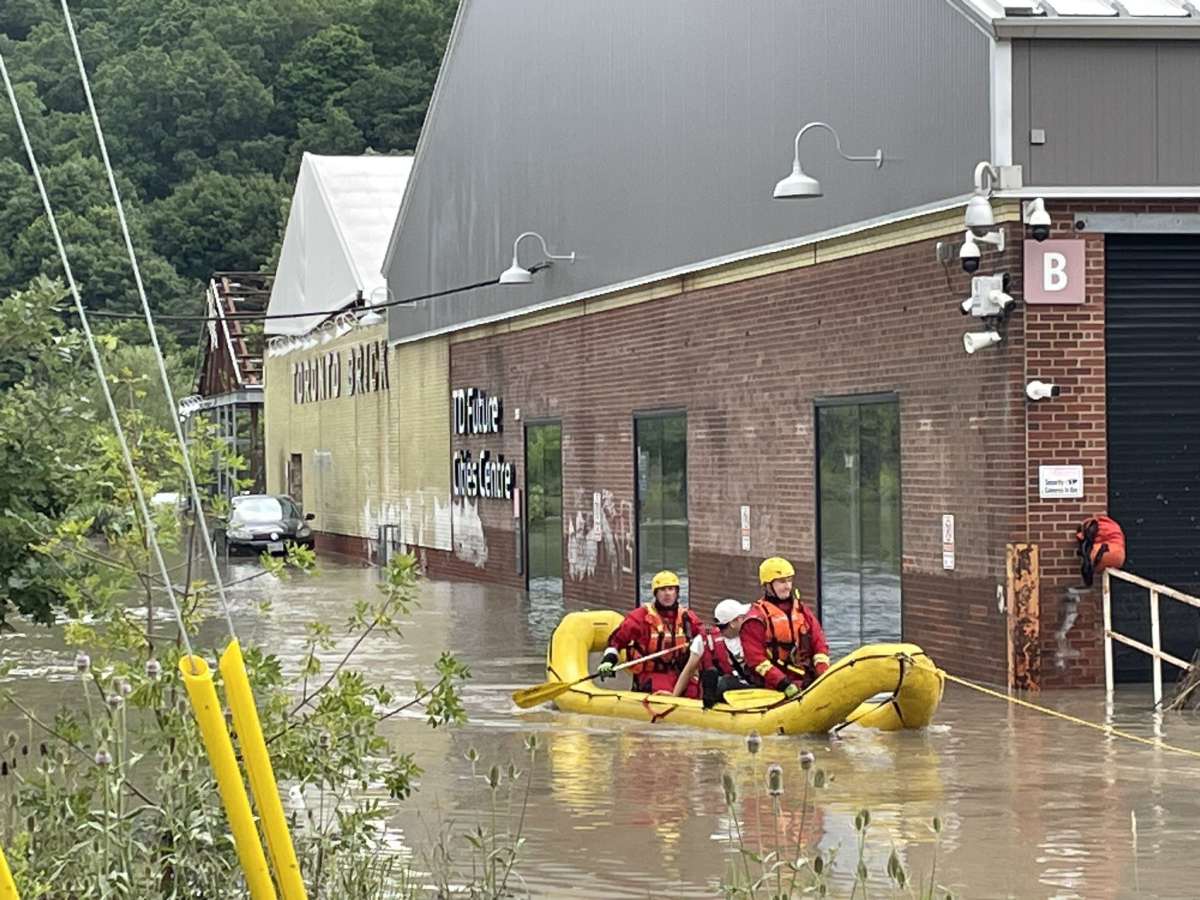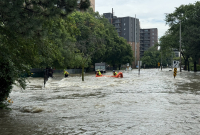Support strong Canadian climate journalism for 2025
As Toronto recovers from this week’s devastating deluge, experts and advocates say a combination of climate change, outdated infrastructure and policy gaps are to blame for the severe flooding that shut down roads, critical buildings and services.
They say there’s an urgent need for a forward-looking approach to flood management and climate resilience to mitigate future disasters in Toronto and other cities.
“Climate change is one of the key drivers of incidents such as the flooding that occurred in Toronto-GTA over the last few days,” said Kathryn Bakos, managing director of finance and resilience at the University of Waterloo’s Intact Centre on Climate Adaptation.
“However, it is important to note that it is not the only reason.”
Bakos says other factors are exacerbating the problem - like aging infrastructure and loss of natural habitats such as water-absorbing wetlands and forests. In southern Ontario alone, 72 per cent of original wetlands have been lost to activities like agriculture, urban sprawl and other land conversion, she said.
“The remaining natural infrastructure that we do have experiences multiple catastrophic rains in a row, such as what the GTA experienced over the last few days,” Bakos said. “These lands become saturated and the water has nowhere to go, causing widespread flooding.”
According to an Environmental Defence report, presciently titled, “Flooding soon in a basement near you,” wetlands in Ontario have drastically declined, especially in southern Ontario.
Earlier this year, a coalition of 65 organizations warned about the Ford government’s “red tape cuts'” aimed at expediting home-building, which they argue endanger wetlands, farmland and natural areas as cities sprawl. The coalition said the loss of wetlands intensifies flooding by compromising the land’s ability to absorb rainwater.
Bakos emphasized the importance of climate adaptation to help mitigate the effects of extreme weather.
Generally, climate adaptation is defined as any activity that reduces the negative impacts of climate change. Examples include early warning systems, infrastructure improvements, nature-based solutions and insurance incentives.
“Notably, every dollar invested in adaptation yields on average savings of $3 to $8 in cost avoidance over a 10-year period,” Bakos said. “Consequently, it is more cost-effective to enhance resilience and implement adaptation measures now, rather than delaying action to the future.”
David Miller, former Toronto mayor and managing director of C40 Centre of Urban Climate Policy and Economy said extreme weather is going to become more and more frequent as the climate warms, so even existing systems will have a hard time keeping up with these increasingly intense storms.
“The severity of the climate-change-affected storms is extremely unusual in terms of the amount of rain in a short period of time, which means that the land cannot absorb it. Picture a sodden sponge and its inability to absorb more water,” said Miller, whose book, SOLVED: How the World’s Great Cities Are Fixing the Climate Crisis, strives to prepare cities for this future.
Miller pointed out that Toronto's stormwater systems, originally designed for rare extreme events occurring every 50 to 100 years, are now strained annually. He said the problem isn’t going away until emissions are brought under control — but even then, cities will need to be built with climate change in mind.
“We need to be even more serious about preventing the problem by doing our part to lower emissions,” Miller said. “The province isn't taking serious action about this, promoting sprawl and gas. We need to make Toronto and other cities low carbon by densifying around transit so people don't need to drive, ending the use of gas wherever possible and mandating all new buildings be net zero or climate positive.”
He also stressed the importance of reducing impermeable surfaces like paved areas and using green roofs or permeable paving to improve water absorption.
This week’s storm saw as much rain fall on the city in four hours as would normally fall in the entire month.
“Climate scientists have said for years that rainfall patterns are becoming more extreme and they will only get worse,” said Daniel Henstra, co-lead of the Climate Risk Research Group and professor of political science at the University of Waterloo. “Although we might get the same volume of rain in a season that we did in the past, it's more likely to come in intense bursts, which causes flash flooding.”

Henstra advocates for a coordinated approach among all levels of government, emphasizing strategies like green infrastructure and the conservation of wetlands to manage stormwater effectively.
He underscored the importance of investing in resilient infrastructure capable of withstanding future extreme weather events, but acknowledges it places a financial burden on residents — and presents a political challenge for leaders.
Earlier this year, Toronto cancelled online public consultations and meetings on a plan to charge homeowners and businesses for paved surfaces on their properties. The proposal, aimed at offsetting costs for managing stormwater and basement flooding, sparked public backlash and drew negative international media attention, earning it the moniker "the rain tax."
In last year’s city budget, a 10-year plan (2023 to 2032) allocated $4.3 billion for stormwater management, including the $2.11-billion Basement Flooding Protection Program. Last year alone, the city invested $225.3 million in the basement program.
Along with her neighbours in the city’s northwest, Sarah Buchanan, campaigns director at Toronto Environmental Alliance, experienced basement flooding and power outages.
“We also had no data signal in most of the area, cutting us off from many loved ones. My child's daycare also lost power. I went in to pick him up and not only was his play area completely flooded out, but the centre itself had lost power,” she recalled.
Buchanan emphasized the need for community resilience.
“This was a good reminder that these events can very quickly throw us into unexpected emergency situations where we rely on neighbours and friends,” she said.
The primary contributors to urban flooding, according to Buchanan, include extensive paved surfaces that prevent water absorption into the ground. She noted that nearly a quarter of Toronto's land area consists of paved streets, with significant off-street parking exacerbating the issue.
“Toronto needs to improve its grey infrastructure and has many plans to do so, but the city has many cost-effective opportunities to improve the green infrastructure that plays a key role in absorbing stormwater before it ever reaches the sewer system.”
The City of Toronto explains that grey infrastructure can be underground pipes, reservoirs or treatment plants designed and constructed to capture or treat stormwater or sanitary sewage. Green infrastructure includes natural or human-made elements such as natural heritage features, parklands, stormwater management systems, street trees, urban forests, natural channels, permeable surfaces and green roofs.
During a press conference yesterday, Prime Minister Justin Trudeau emphasized the critical need for resilient infrastructure to mitigate future risks.
“Reality is, though, that with climate change, there are going to be more extreme weather events,” Trudeau said. “We need to continue to step up on our fight against climate change.”
Trudeau highlighted his government’s investment in about a dozen flood-resilient infrastructure projects and various measures for the City of Toronto.
“We are going to continue to be there to make sure that people are safe and that infrastructure needs are met.”






Comments
First point.
"[David Miller] said the problem isn’t going away until emissions are brought under control — but even then, cities will need to be built with climate change in mind."
That's incorrect. Even of we brought emissions to zero tomorrow, the changes we have caused, to date, are with us for generations (in fact, they will likely get worse before conditions stabilize), until atmospheric GHG concentrations are reduced.
https://royalsociety.org/news-resources/projects/climate-change-evidenc…
https://search.brave.com/search?q=if+greenhouse+gas+emissions+are+reduc…
Second point.
I'd argue that most of the legislative solutions fall under areas of provincial jurisdiction, so all the talk about involving "multiple levels of gov't" is misleading. That's why having such self-interested individuals, such as Doug Ford, in positions of provincial power is so detrimental to our collective future. One can look more broadly at many provincial governments in Canada to find they are mere lackies and useful idiots for major industries and even mere families that have a "controlling interest" in provincial commerce and, thus, politics. And, sadly, these people care about only one thing: the size of their bank accounts. Although, I'm sure they also get a kick out of pulling the strings of their elected puppets and manipulating the public.